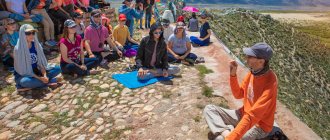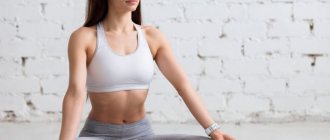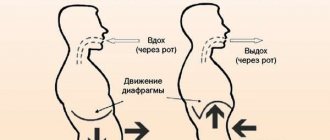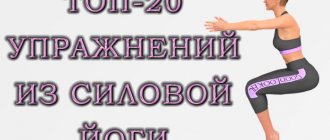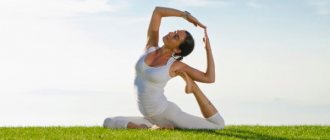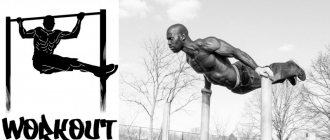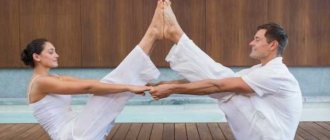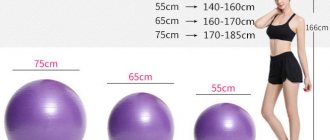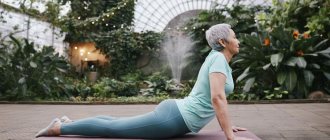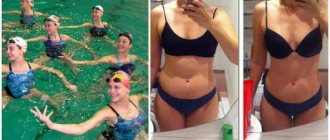For most people, the path to yoga begins with asanas. At first, their diversity may puzzle inexperienced practitioners. But, if you make regular efforts, it is quite possible to master all the asanas in yoga for beginners in a short time. A person, always in a hurry and trying to do everything, sometimes needs to stop and dive inside himself, so as not to completely lose his true nature among the endless flow of information, things, desires, ambitions. Sooner or later, everyone who is looking for such an island of peace comes to yoga, which can offer different tools to achieve the main goal - finding harmony and peace in the soul.
Yoga has long taken a strong position among the variety of types of physical activity. Such popularity could not help but attract the attention of researchers in various branches of science. How does the body work in asanas? What happens to the brain during meditation? What diseases can be healed through practice? Today, based on the personal experience of millions of people and hundreds of scientific studies, we can talk about the benefits of yoga for the whole body.
Positive effects of yoga
- improves the condition of the spine, joints, strengthens bones;
- strengthens muscles, keeps them in good shape;
- has a positive effect on the functioning of the cardiovascular system;
- increases immunity, stimulates the lymphatic system;
- regulates blood pressure;
- normalizes the functioning of the adrenal glands;
- reduces blood sugar levels;
- improves lung function;
- prevents digestive problems;
- supports the nervous system;
- increases the ability to concentrate;
- teaches you to hear inner needs;
- relieves stress, improves sleep quality;
- gives a feeling of happiness, peace of mind;
- opens the way to spiritual development.
A simple and visual system for learning the basics of yoga comes to the rescue - asanas in pictures. You will not only learn how to perform asanas and remember their names, but you will also be able to create a variety of complexes to improve your health or to master more complex yogic exercises. In other words, “Yoga Asanas: Names and Pictures” is your guide to the world of yoga.
How to create a yoga routine for beginners? Take as a basis the names of yoga asanas with images!
A video lecture will also help you with this, where you will learn what techniques it is advisable to include in the morning and evening practice of hatha yoga:
Hormone release
If a woman’s body produces unstable secretions from the endocrine glands, an imbalance occurs. An incorrect balance of chemical elements in the blood leads to psychological problems. It is directly related to the spiritual state of a person. Yoga is aimed at improving work by improving blood circulation in the head.
Sun salutation yoga - a set of warm-up exercises and tips for beginners on how to do the exercise correctly (115 photos)Morning yoga for beginners: sets of exercises, their benefits and recommendations from experienced trainers (120 photos)
Yoga for beginners at home - an overview of basic workouts and basic exercises. Basic concepts of modern practices (135 photos and videos)
What does a yoga complex consist of?
- Warm-up (joint gymnastics, several circles of Surya Namaskar) “launches” all body systems, prepares muscles and joints for practice. Standing asanas strengthen the legs, tone the muscles, and work the lower chakras.
- Standing balances improve concentration and tune the mind to contemplative practice.
- Hand balances strengthen your arms and enhance your concentration practice.
- Seated asanas work on all areas of spinal mobility, strengthen the abs, and promote muscle stretching.
- Positions to open the thoracic region fill the Anahata chakra with energy and increase the mobility of the thoracic spine.
- Positions to open the hip joints help to master meditative asanas and are a good prevention of joint diseases.
- Inversion exercises increase venous drainage from the lower extremities and also move energy to higher energy centers.
- Shavasana relaxes, calms, removes mental blocks, and allows you to feel inner sensations.
Relieves tension
Many representatives of the fair sex lead a sedentary lifestyle, thanks to their activities in professional fields.
When sitting for a long time, be it at the computer or at the checkout counter in a store, back disease develops - osteochondrosis or varicose veins, despite improper blood circulation. A series of workouts relieves muscle tension, prevents swelling, and circulates red fluid throughout the body.
Basic asanas
- Standing: Tadasana, Virabhadrasana I and II, Uttanasana.
- Standing balance asanas: Vrikshasana, Virabhadrasana III, Garudasana, Natarajasana.
- Balance on hands: Bakasana, Bhuja Pidasana.
- Sitting (bends, twists, backbends): Paschimottanasana, Ardha Matsyendrasana, Virasana, Marichasana.
- To open the thoracic region: Bhuja Svastikasana, Ushtrasana.
- To open the hip joints: Janu Shirshasana, Akarna Dhanurasana, Baddha Konasana.
- Inverted asanas: Halasana, Viparita Karani Mudra, Sarvangasana.
- Shavasana.
By using 108 yoga asanas, you can achieve a high level of personal practice, and not only on the physical plane. Working correctly with the body, we influence subtle structures—energy channels and centers—thus changing the quality of energy.
You can study the asanas in detail and master the methodology for creating a yoga complex for beginners in the yoga teacher course.
What to do if you can’t master yoga asanas from photos? Try studying online with experienced teachers who explain how to properly build body positions.
Eliminates fatigue
By doing yoga, you can forget about fatigue in your feet when wearing high-heeled shoes for a long time. There are ways to easily relieve stress when walking in high heels.
If you accurately distribute the load on certain muscles throughout the body, you can get rid of many problems, such as aches in the spine, or knees, as well as all joints in general.
Material
Cotton fabrics are excellent for exercise, with a small percentage of synthetics added, they do not irritate the skin, stretch well, and do not tear. Also, the fabric should not be translucent.
Plank (Kumbhakasana)
Chances are you've heard of the plank or seen pictures of it, and perhaps even done it at some point. In yoga, it is called Kumbhakasana, and its implementation is no different from the gymnastic version.
- We stand on all fours, place our hands perpendicular to the floor, that is, the bases of our palms should be exactly under the line of our shoulders.
- Straighten your legs, placing your feet hip-width apart.
- We rest our toes on the floor, spread our fingers, evenly distributing the weight on them.
- We strain the gluteal muscles and abdominal muscles, avoiding lumbar deflection - the body should become a straight line.
- We direct our gaze forward, do not lower our head, monitor our breathing - it should be even and calm.
- We stay in this position for half a minute or a minute.
- Exhaling, we lower our knees to the floor and return to the starting position.
If your wrists get very tired, try to “give” more weight to your fingers. To put more stress on your arm muscles and take the stress off your joints, you can bend your elbows slightly, making them “soft.”
Plank
The plank does an excellent job of strengthening the arms, legs and spine, training the abdominal muscles, developing endurance, and also relieving stress. Plus, the plank is a great way to lose weight at home. The more often you practice this asana, the longer you will be able to stay in it.
First Warrior Pose (Virabhadrasana I)
The Warrior pose has several varieties, let's look at the basic one - the first of them.
- Let's get into Mountain pose.
- Raise your arms straight above your head so that your palms touch.
- We take a deep breath and step back with our left foot so that our legs are spaced about 120 centimeters wide.
- The right foot and body continue to look forward, we turn the left foot slightly inward. The right shin should be perpendicular to the floor. The pelvis is closed, that is, it also looks towards the right thigh.
- Strive to get your right thigh parallel to the floor, but don't rush or despair if you fail - this will only come with practice.
- We strain the muscles of the left knee and straighten the leg.
- We straighten our spine and direct our gaze to our palms.
- We remain in this position for half a minute, do not forget to breathe evenly and calmly.
- We repeat the previous points, but on the other side.
- We exhale and return to Tadasana.
Warrior Pose I
If it is difficult to maintain balance, look not at your palms, but at one point in front of you. Be sure to relax and stretch your neck.
Video: Technique for performing Warrior I pose
The Warrior pose is a general strengthening exercise - the muscles of the back, legs, and upper body are strengthened. It also improves coordination and balance.
Style and comfort
Since your guru trainer must ensure the correct execution of various stances, it is important to wear pants that fit tightly to your legs. Everyone knows that black color makes the figure very small and slender, but in brighter shades, the knees will be well outlined and the instructor will see all the nuances and it will be easier to correct mistakes.
The main thing is minimalism in details. Get rid of danglers, buttons, ruffles that can prevent you from performing certain stances.
Exercises
Yoga practitioners, as a rule, are divided into three groups :
- beginners;
- people with good physical fitness;
- professionals.
Exercises are developed individually for each group.
For newbies
The simplest and most accessible asanas at all levels of training are considered to be:
Double breathing . Partners sit sitting, leaning on their backs. The first participant takes a slow deep breath, the second, synchronously with him, exhales smoothly. The duration of breathing practice is from three to five minutes on average. The main task is to concentrate on your partner, feel him and not disrupt the breathing rhythm throughout the entire practice.
Entwining your partner . Take a lotus position with your backs touching each other. From this position, stretch up and make a smooth turn over your left shoulder towards your partner. The left hand falls on the partner’s right knee, the right hand rests on his left knee. Stay in this figure for five to six breathing cycles. Then take the lotus position again. Each action should reflect the partner’s action, like a mirror.
Double dog . One partner does Downward-Facing Dog, the second stands on his hands and places his left and right feet alternately on his lower back. After completing 5-6 breathing cycles, switch places.
Triangle . Standing position, back to back, legs spread wide. With your left hand, try to reach your right foot, place your hand next to it. Raise your right one up so that your arms line up in a straight vertical line.
For physically fit people
Complex set of exercises:
Seated tilt towards the feet . Take a sitting position with straight legs. Lean your body forward as much as possible. Meanwhile, your partner should carefully position themselves in a lying position on your back.
Legendary meditation course without payment We recommend! The most popular meditation course for beginners in Russian. More than 100 thousand people have already learned to meditate. Try it yourself. Read more.
Boat . Sitting face to face. Hold hands. Open your legs as wide as possible and lift them simultaneously, continuing to hold hands.
Tilts . Sit opposite each other. Straighten your legs so that your feet are touching. Hold your hands, trying not to bend your knees.
For professionals
For experienced practitioners or people with strong stretching, it is suggested to perform the asanas listed below:
Dandasana. One person sits on the floor with their legs spread wide apart. The second, standing near the knees of the person sitting, rests his hands on his knees, and places his legs on his hands. The participant holding the legs slowly raises their arms until they are fully extended. The final result should be a square shape.
Floating Bow . One participant, lying on his back, raises his legs bent at the knees. His partner, standing with his back, gently rests his buttocks on his feet. Next, the person in a sitting position smoothly raises his legs. It is important for the soarer to relax and maintain balance.
Cobra. One participant lies on the floor, stomach down. The second person places his feet at the level of the thighs of the person lying down, takes the hands of the first participant and bends back. As a result, the person lying down must perform the “Cobra” asana.
Each of the listed asanas should be performed synchronously or alternately. The time required to perform the figure is from four to six breathing cycles, that is, an approximate time of 3-5 minutes. All movements are performed smoothly, without sudden movements, to avoid injuries during the yoga challenge.
Tree Pose (Vrikshasana) with photo
It is not for nothing that the subtleties of Tadasana are comprehended first. The performance of Vrikshasana begins with the initial application of Mountain Pose.
- Let's get into Tadasana.
- Having bent the right leg at the knee joint, we raise it until the heel rests on the base of the inner part of the left thigh.
- We place the foot on the surface of the thigh so that the toes point down.
- We maintain balance while standing on our left leg, point our arms up and straighten them parallel to each other, then join our palms. We move our shoulders away from our ears.
- We stand in this asana for 30 seconds (gradually increasing the time), and be sure to remember to breathe deeply.
- After a while, we separate and lower our arms, straighten the bent leg and take the starting position.
- Having relaxed, we repeat the pose on the other leg.
Tree pose
Thanks to Vrikshasana, the following happens:
- prevention of flat feet;
- improved posture;
- relaxation of shoulder joints;
- strengthening the muscles of the upper body;
- increase in lung volume;
- restoration of blood circulation;
- balance and coordination training;
- energy surge;
- the appearance of lightness and confidence.
How to breathe correctly
To achieve this, you need to constantly check your breathing. It is important to consider several points:
- Proper breathing helps reduce muscle tension and pain.
- It is necessary to listen to the instructor, some entrances to asanas are at the moment of “inhalation”, and others at the moment of exhalation.
- There should be at least 1-2 hours between your last meal and exercise. Otherwise, breathing may cause abdominal pain.
- Moderate breathing supplies the muscles with oxygen, which helps a person perform strength training.
